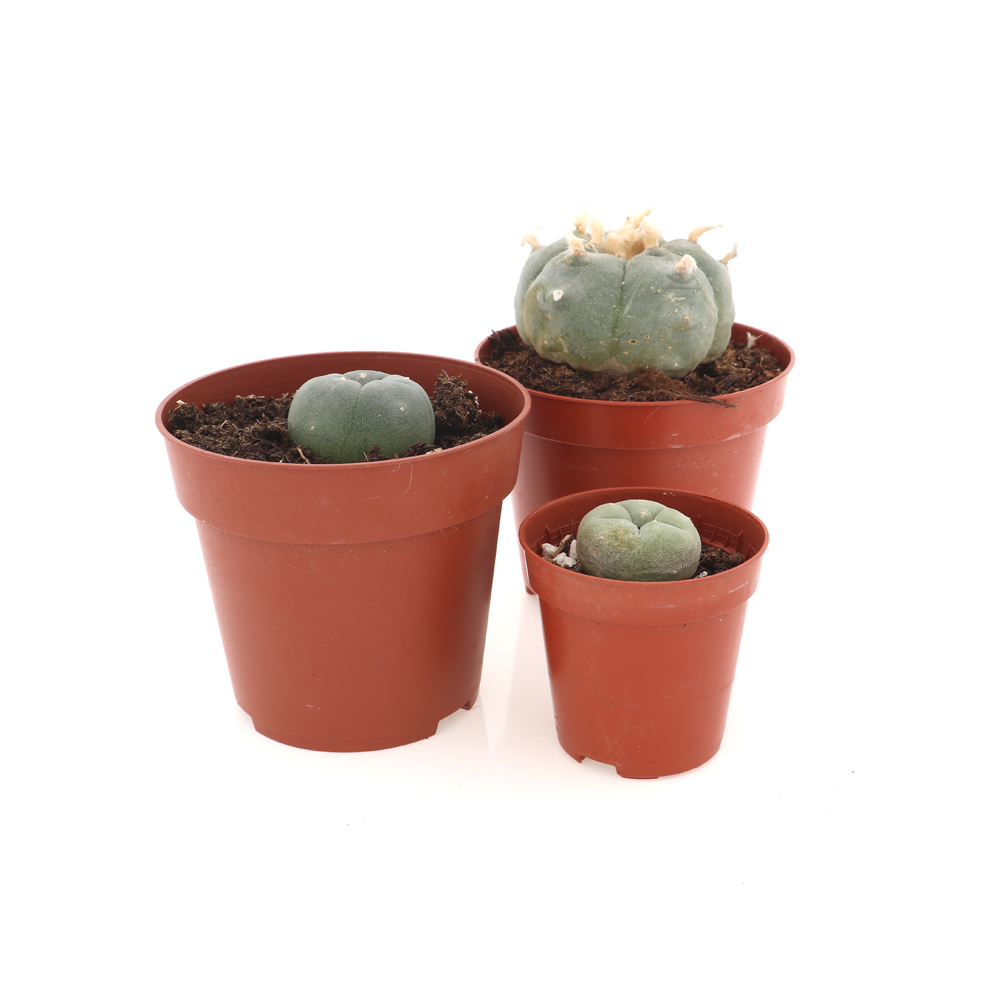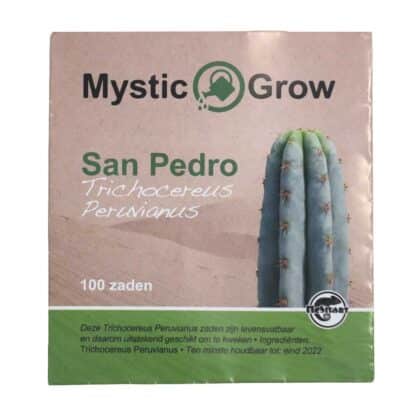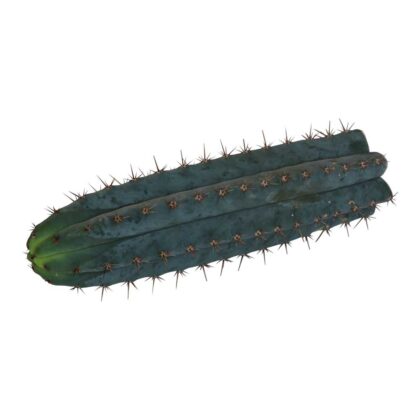Peyote (Lophophora Williamsii)
€12,95 - €65,00Prijsklasse: €12,95 tot €65,00 incl. btw
The Peyote cactus, scientifically known as Lophophora williamsii, is a small, spineless plant celebrated for its powerful psychoactive effects, primarily due to its natural mescaline content. Indigenous to northern Mexico and the southern United States, this remarkable cactus has been used for centuries in spiritual ceremonies, providing deeply transformative, consciousness-expanding experiences.
What Is the Peyote Cactus?
The Peyote cactus is a small, round, spineless plant native to the arid regions of northern Mexico and the southern United States. It is known for its psychoactive properties, primarily due to its high mescaline content—a natural compound that induces vivid hallucinations, altered perception, and unique sensory experiences.
This cactus blooms with delicate pink flowers and grows very slowly, taking 8 to 15 years to reach maturity. Its use has deep spiritual roots among indigenous cultures, often featured in religious and ceremonial contexts. The cactus is typically consumed for its mind-altering effects, which can be profound and transformative when approached with care.
Despite its potential for personal insight, Peyote must be used responsibly. The experience should take place in a safe environment with a sober tripsitter present. Those with underlying physical or mental health conditions should avoid its use due to the intensity of its effects.
History of the Peyote Cactus
The Peyote cactus has been a central element in indigenous spiritual practices for centuries. Tribes such as the Huichol and Tarahumara have long used it in ceremonies to facilitate visions and a sense of connection with the divine. Consumed communally, Peyote played a role in promoting introspection, healing, and unity.
European explorers first documented Peyote use in the 16th century, although Western understanding remained limited until the 19th century, when mescaline was studied by scientists. In the 20th century, Peyote gained attention during the counterculture movement and began to appear outside indigenous circles.
Despite legal restrictions in some areas due to its psychoactive nature, Peyote remains legally protected for certain religious practices. Today, it is valued both for its spiritual heritage and its psychological effects, though modern users are urged to honor its cultural origins and use it with reverence.
How to Use the Peyote Cactus
Using Peyote requires thoughtful preparation and responsible conduct. It can be consumed fresh or dried, often sliced into small discs approximately 3–4.5 cm wide and 0.5 cm thick. Some users prefer to brew it into tea to make the bitter taste more palatable.
For optimal results, take Peyote on an empty stomach to enhance absorption. Effects typically begin within 30–60 minutes, peak after 1–2 hours, and can last between 8–15 hours. Because the experience can be intense, it’s important to be in a familiar, calm environment with a sober guide present.
Start with a low dose, especially if you are new to psychoactive substances. Avoid combining Peyote with alcohol, other drugs, or medications. It should not be used by minors, pregnant individuals, or those with health conditions. After the experience, allow time to rest and reflect to fully integrate the insights gained.
Lophophora williamsii as Ornamental Plant
Lophophora williamsii, or peyote as it’s often called, enchants collectors with its unique button-like form, sturdy build, and leisurely growth rate, ideal for enhancing collections of uncommon succulents. We feature this item on our site not solely as a decorative ornamental, but also as a multifaceted option that showcases its aesthetic charm from the soft, bluish-green surface to the refined, knobbed edges that bring an artistic flair to shelves, conservatories, or sleek arrangements. Designed for markets where it’s legally available, these lab-grown plants comply fully with governing laws, steering clear of any hints toward consumption or extraction, so buyers can simply relish it as a captivating, natural decor piece for their living spaces or outdoor areas.
Ingredients of the Peyote Cactus
The key active compound in Peyote is mescaline (3,4,5-trimethoxyphenethylamine), a powerful hallucinogen responsible for the cactus’s psychoactive effects. Mescaline produces intense visual and sensory experiences, making it the primary reason for the plant’s spiritual and recreational use.
In addition to mescaline, Peyote contains several other naturally occurring alkaloids in small amounts, though their specific effects are less well understood. The potency of the cactus can vary depending on environmental factors such as soil and climate.
Peyote is a pure, organic product, free from artificial additives. Its slow maturation process—up to 15 years—allows the active compounds to concentrate, resulting in a potent substance. Due to mescaline’s strength, it should be approached with caution, particularly by those with health vulnerabilities.
Warning
Peyote is not a casual substance—it contains mescaline, which can lead to intense psychological effects including hallucinations, disorientation, and profound emotional shifts. Use it only in a secure setting, with a sober sitter to assist if necessary.
Do not consume Peyote if you suffer from mental health conditions such as anxiety, depression, or psychosis, or if you have physical health concerns like heart problems, diabetes, or respiratory issues. Pregnant individuals and minors should avoid it entirely.
Never mix Peyote with alcohol, medications, or other psychoactive substances. Doing so increases the risk of dangerous side effects. Avoid driving or operating machinery during or after use, and always store it safely out of reach of children.
Though the experience can be enlightening, Peyote must be used with the utmost respect and caution. A mindful approach ensures a safer and more meaningful journey.
Do you ship to my country?
We ship to most EU countries. You can find these in the table below. We ship all our EU packages with DHL, DPD or PostNL depending on the area. This way we can deliver the best service possible. You will always receive a track and trace code to track your package from door to door.
| Country | Delivery | Costs | Free shipping |
|---|---|---|---|
| Austria | 2 - 3 | €11,95 | €125,- |
| Belgium | 1 - 2 | €7,95 | €125,- |
| Bulgaria | 6 - 8 | €21,95 | €125,- |
| Croatia | 3 - 5 | €17,95 | €125,- |
| Czech Republic | 2 - 4 | €13,95 | €125,- |
| Estonia | 4 - 6 | €19,95 | €125,- |
| France | 2 - 3 | €10,95 | €125,- |
| Germany | 1 - 3 | €7,95 | €125,- |
| Greece | 6 - 8 | €21,95 | €125,- |
| Ireland | 3 - 4 | €16,95 | €125,- |
| Italy | 2 - 4 | €18,95 | €125,- |
| Latvia | 3 - 5 | €15,95 | €125,- |
| Lithuania | 3 - 5 | €22,95 | €125,- |
| Luxembourg | 1 - 2 | €11,95 | €125,- |
| Netherlands | 1 - 2 | €6,95 | €125,- |
| Poland | 2 - 3 | €14,95 | €125,- |
| Portugal | 3 - 4 | €20,95 | €125,- |
| Romania | 3 - 5 | €17,95 | €125,- |
| Slovakia | 3 - 5 | €17,95 | €125,- |
| Slovenia | 2 - 3 | €17,95 | €125,- |
| Spain | 2 - 3 | €14,95 | €125,- |
* Difficult to reach areas like Islands or other remote regions will cost around €20,- more due to additional carrier fees.
Note: We try to ship all orders within 1 working day, all delivery times are estimated and can vary because of traffic and holidays.




